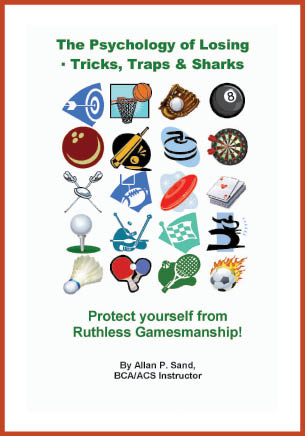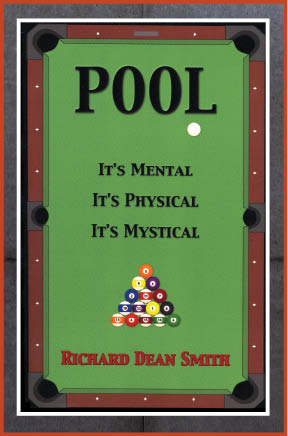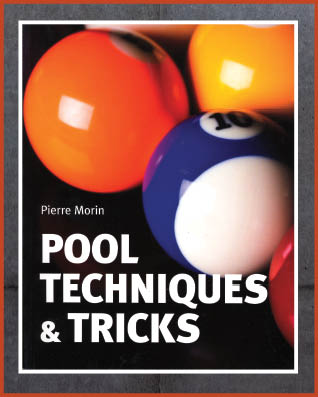|
|
Current Issue
Next Page >

|
 The Psychology of Losing
The Psychology of Losing
Allan Sand
FIRST UP is a highly entertaining/educating project from one of the cue games' more worldly authors, Allan Sand (his titles include "The Art of War vs. The Art of Pool"). This time, it's an entire treatise on sharking, tenderly titled "The Psychology of Losing - Tricks, Traps & Sharks."
Sand's cheery premise is that sharking exists in our everyday lives; indeed, on a daily basis, we shark other people and in turn endure their sharking techniques on us. The author even claims that Sun Tzu utilized sharking in "The Art of War," which is, oh, roughly 2,100 years older than any form of billiards. Invoking history still further, he believes the famous Trojan horse to be the ultimate shark.
Not that I have any personal experience with this, either literally or metaphorically, but one of my favorite chapters in "The Psychology of Losing" is called, with howling political incorrectness, "Alzheimer's." Most of us have been on the wrong side of this; at its broadest, the ploy presents questions such as, "Is it my turn again?" And it can be game-specific, too: "Am I stripes or solids this time?" for 8-ball. "Which pocket is mine again?" for one-hole. "Help me with the score," for straight pool. I can't imagine having the stones to try any form of this unless you're of retirement age or greater, but then again, as I said, I really don't know from Alzheimer's.
www.billiardgods.com * $23.99
 Pool: It's Mental, It's Physical, It's Mystical
Pool: It's Mental, It's Physical, It's Mystical
Dr. Richard Smith
THE NEXT author's name may or may not be familiar to you; he's Dr. Richard Dean Smith, a northern California physician who's written nine non-fiction books on subjects as diverse as the science of Herman Melville and histories of the mass medical movement. Here he offers us "Pool: It's Mental, It's Physical, It's Mystical." Here are 270+ pages on the mental game; there is not a single balls-on-table diagram, nor any specific shot instruction.
Smith's book is not especially easy reading; he quotes Cervantes, Sophocles and Shakespeare among others, and discusses such topics as internal imaging and cognitive anxiety. Oddly, there's a chapter that quotes, of all players, the great Willie Mosconi, one of the more closed-mouth competitors who ever chalked a cue. Here he reprises about the only two points he was known to make: practice does not improve concentration or self-discipline, and the only real way to improve is to compete with players better than you. But he also goes a bit further than that, commenting briefly on intimidation, concentration and both physical and mental fatigue.
This book requires an additional helping of patience in the reading. Dr. Smith does some player name-dropping (if Danny D. is such a good friend of his, how come he calls him Danny D'Imperio?), and you will long for more specific playing references. Still, if you can stay with it, you will recognize countless reactions and attitudes within yourself, and have the priceless opportunity to change and improve them.
www.friesenpress.com * $18.99
 Pool Techniques & Tricks
Pool Techniques & Tricks
Pierre Morin
POOL TECHNIQUES & Tricks," from one of Canada's best-known players, Pierre Morin, actually targets two separate audiences. Part 1 deals with the basics, thus addresses beginners; Part 2 teaches over 100 trick shots, and it's awfully difficult to imagine the same individual who wants to learn both.
The real star of this book is its production values. It's a paperback, but printed on top-quality stock with excellent four-color photos (very few b/w diagrams) throughout. Morin devotes exactly 106 pages to each subject. The only reason to consider this book for its first chapter is if you're gifting someone who hasn't already read of pool's basics. It's almost impossible to do anything new in writing of them; Morin's book, as thorough as it is in covering the fundamentals, does not break much new ground. It's a generous helping of old wine in a very handsome new bottle.
The trick-shots chapter is better; you've seen many of these before, some not. The instruction is superb throughout. But from this point of view, why bother putting all this time and effort into this sort of teaching when there are hardly any students? How much demand for trick-shot exhibitions can there possibly be (except when tacked onto a bona fide teaching seminar), and how much can they possibly pay?
Another curiosity here is why Morin pays mere lip service to the archaic straight-pool form known as lineup pool, including it only in a brief list of games and their rules. If you want to improve your nip/draw stroke for either straight pool or one-pocket, you can hardly do better than practice a few frames of lineup (but Morin does not include practice drills here); further, he is said, by no less than our own brilliant Michael Shamos, to be the world's ranking authority on the game, and its players and records.
Still, no book has ever combined these two modes of instruction before, and all told "Pool Techniques & Tricks" is a very ambitious effort. (Did you know that the formal names for carom shots and kicks are "ricochets" and "bricuses", respectively? They are in Canada.)
www.fireflybooks.com * $24.95
Next Page >
Top |
|





